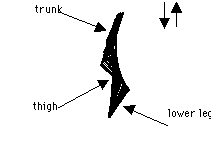RESULTS
Temporal Analysis
For the squat, the movement began with flexion at the knee, and
ended with full extension of the knee. The leg press movement began
when the heels of the subject's feet were in full contact with the
machine and when extension at the knee began. The leg press movement
ended with a return to the starting flexion position. The total time
for squat was 2.84 seconds; for leg press the time was 2.64
seconds.In squat, flexion occupied 56.8% ( 1.61 sec.) of the cycle,
while extension occupied 43.2% (1.23 sec.) of the cycle. In legpress,
flexion occupied 61.4% (1.62 sec.) of the cycle, while extension
occupied 38.6% (1.23 sec.) of the cycle.
Qualitative Analysis
Our movements were the squat and the leg press; both involving the
flexion and extension of the knee. The main difference between the
two occurs in the overall body position. In squat, knee flexion and
extension occurs in standing position. In leg press, flexion and
extension occur in a reclined sitting position. Squat begins from a
fully extended position, then the hip and the knee flex (flexor
phase) followed by hip and knee extension (extensor phase). Leg press
begins with the hip and the knees in a partially flexed position,
then both joints extend (extensor phase) followed by hip and knee
flexion back to original position. In squat, the midsection moves
backwards with flexion and forwards with extension. In leg press,
there is little movement of the midsection. There is also difference
between the two exercises in where the resistance of the machine is
located. In squat, the resistance is located at the shoulders and in
the leg press the resistance is located at the feet. These movements
are represented by the stick figures in Figure 2.
|

|

|
|
Figure 2. Body motion in the squat (left) and the leg
press (right).The body segments are indicated as labeled in
the figures. For squat, flexion is in the downward direction
and extension is in the upward direction. For legpress,
extension is towards the right while flexion is towards the
left.
|

